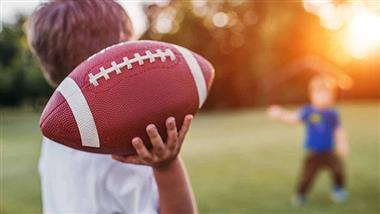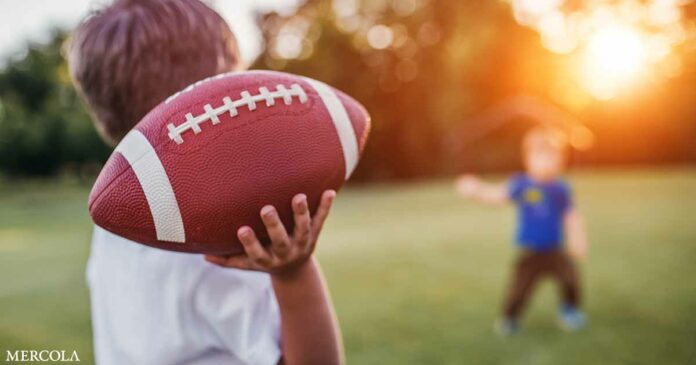
Story at-a-glance
- Children who participate in multiple sports develop significantly better motor skills than those who specialize in just one sport or remain inactive
- Research shows children in multisport programs outperformed single-sport participants by up to 14.5% in coordination, balance and movement tests
- Unstructured outdoor play for 30 to 60 minutes daily particularly benefits girls, improving their coordination by 8.4% to 14.5% compared to less active peers
- Early movement patterns establish a foundation that influences physical abilities into adolescence, with coordination advantages persisting over time
- Parents should prioritize variety over intensity, avoid year-round specialization in one sport and choose programs that teach fundamental movement skills
Whether your child becomes active, confident and coordinated later in life often comes down to one thing: how they move in their early years. Movement skills like running, jumping and throwing aren’t just about physical activity — they’re the foundation for independence, self-esteem and even brain development. These early patterns set the stage for how easily a child takes on physical challenges as they grow.
But here’s where most people get it wrong: not all movement builds coordination the same way. What your child does, and how often they switch it up, matters more than simply being busy or enrolled in a sport. What’s missing from most conversations is the role that variety, structure and playtime all have in shaping a child’s ability to move well and stay active long-term.
If you’re unsure whether your child needs more structured sports, more outdoor time or a different mix entirely, the latest research offers some surprising clarity. In the next section, I’ll walk you through what those findings reveal, and how to use that information to make smarter choices for your child’s development.
Children Who Played More Than One Sport Had Stronger Coordination Years Later
Published in the Journal of Sports Science, a study tracked 627 children in Finland over three years to understand how early physical activity affected coordination and movement skills by age 11.1 Researchers focused on two types of physical activity: organized sports (like team sports or lessons) and unstructured outdoor play. The goal was to determine whether these different kinds of movement shaped motor coordination, balance and overall movement skills down the line.
• Researchers assessed jumping, throwing, running and balance — The children were tested using a standard physical skills assessment and a jumping test. These are widely used tools to measure basic motor functions.
The study looked at four categories of movement: locomotor skills (running, hopping), object control skills (like throwing or dribbling), a combined score of the two and dynamic balance, which was measured by counting how many times the child could jump side to side in 15 seconds.
• Children in multiple sports improved more than children in just one — The more sports a child participated in, the stronger their performance across all motor categories. Specifically, children who played in two or more sports had 10.1% higher jumping scores and up to 14.5% better coordination than children who didn’t participate in sports at all. Participation in just one sport still helped, but not nearly as much, especially for jumping and running-based tasks.
• Outdoor play helped girls more than boys — Among girls, 30 to 60 minutes of outdoor play after school led to measurable improvements in coordination. These girls outperformed peers who spent less than 30 minutes outdoors by 8.4% to 14.5%, depending on the skill being tested.
Surprisingly, this improvement wasn’t seen in boys, even though they typically spent more time outside than girls. Researchers suggested boys may already be hitting their activity threshold, while girls benefit from even a modest boost in outdoor play.
The Benefits Show Up Years Later
The children were first assessed in early childhood (ages 3 to 8), and tested again three years later when they were between 6 and 11 years old. The findings confirm that early activity shapes later coordination — not just in the short term. These results also suggest that early movement habits create a foundation that influences physical ability well into adolescence.
• Movement diversity matters more than intensity — The standout improvements in children who played multiple sports likely come from the variety of motion required in different games and activities. Playing soccer develops different muscles and skills than basketball or gymnastics.
This movement diversity trains the brain and body to coordinate better across a wider range of activities. As a result, these children showed consistently higher scores in both skill-based and balance-based motor tasks.
• Motor competence appears to follow a predictable path — Researchers noted that children who started out with lower movement skills in early childhood often stayed behind, while those who were ahead maintained their advantage over time. This reinforces the importance of early intervention, especially for children who aren’t naturally drawn to movement or don’t have access to diverse physical experiences.
Multisport Training Gave Kids a Major Edge
A related study published in Sports (Basel) evaluated motor coordination in 180 children, roughly 8 years old, divided into three groups: those enrolled in multisport programs, those participating only in swimming and those who were inactive outside of physical education classes.2 The goal was to determine which type of activity, or lack of it, produced the greatest improvements in coordination across four movement tests.
• Multisport children had the highest scores in every category tested — The children in the multisport group significantly outperformed both swimmers and inactive peers in total motor coordination.
This included superior results in hopping, jumping sideways, walking backward and side-to-side movement using wooden boards — skills that reflect balance, agility, strength and timing. On the overall motor skill score, multisport children outpaced swimmers by 13 points and inactive children by nearly 20 points, indicating a meaningful and measurable difference.
• Swimming was better than no activity but still limited — While children in the swimming group did score higher than inactive peers in most tests, their gains were modest. In only one area — walking backwards for balance — did swimmers outperform multisport kids, and even that difference was considered small.
One reason swimming didn’t improve motor coordination as much as multisport is because it lacks key components like gravity-based balancing, directional changes and varied terrain. Swimming teaches endurance and stroke precision, but it doesn’t train children to jump, dodge or coordinate different limbs in unpredictable environments — the kinds of movement real life and most sports demand.
• Every test showed the same trend — variety beat repetition — In jumping sideways — a test of coordination and reaction time — the multisport children outscored swimmers by a statistically significant margin.
In hopping for height, which reflects lower body strength and balance, the difference was nearly six points in favor of the multisport group. For moving sideways, multisport children again topped both other groups, reinforcing the benefit of cross-training over single-sport focus.
Children Didn’t Need Elite Training, Just Consistent Variety
These were not elite athletes. The children in the multisport group attended two one-hour sessions per week in a gym. Each week, instructors rotated the skills being taught, such as throwing, running, jumping and balancing, so children built a diverse foundation of movement knowledge. The structured yet varied exposure is what gave them the edge.
• Inactivity had the most negative impact — Inactive children — those who only had standard physical education in school — scored the lowest across the board. Their motor coordination was significantly weaker than both the swimming and multisport groups. Even compared to swimmers, they had less balance and poorer coordination. This supports the idea that movement skill development requires more than what typical school PE provides.
• The right kind of play sets children up for better lifelong movement — The findings support what many coaches and pediatric experts have long observed: children who build coordination through exposure to different sports are more confident, less injury-prone and more likely to remain active into adulthood. The multisport model not only builds skills — it builds the belief that movement is fun, rewarding and worth repeating.
How to Build Better Motor Skills Through Smarter Movement Choices
If you’re raising a child, you’re in a position to shape how they move for the rest of their life. Poor coordination isn’t just about awkwardness on the playground. It’s a sign that their brain and body aren’t communicating as efficiently as they should, and that has ripple effects on confidence, physical health and even academic performance.
The good news is, you don’t need expensive programs or packed schedules. You just need to focus on the right kind of movement at the right time. Whether your child loves sports or avoids them, there’s a way to help them develop strong motor skills without pressure. Based on what the research shows, here are five steps to consider:
1. Start with variety, not intensity — Don’t rush your child into one sport thinking that’s the fastest way to improve. The data shows the opposite. Multisport children — those doing two or more different activities — develop better overall movement patterns than children who specialize early.
If your child plays soccer in the fall, think about adding something like gymnastics, dance or martial arts in another season. Each sport trains different movement pathways, and that variety is what builds lasting coordination.
2. Make time for unstructured outdoor play every day — If your child is between the ages of 3 and 8, try to ensure they get at least 30 to 60 minutes of outdoor time every weekday after school. This doesn’t need to be formal. Let them run, dig, skip or invent games. For girls especially, this kind of open-ended movement is linked to significant gains in coordination, even if they don’t play sports. The key is that it’s child-directed, creative and consistent.
3. Avoid back-to-back seasons of the same sport — If your child loves a particular sport, like swimming, soccer or basketball, it’s fine to encourage it. But running the same program all year limits their growth. Instead, rotate in sports that challenge different movement types. For example, pair a team sport with a balance-focused activity or a hand-eye coordination sport like tennis. Your child’s brain will wire new motor skills faster when the input changes often.
4. Watch for signs of stagnation — If your child isn’t showing improvement in basic motor skills like hopping, skipping or throwing, don’t wait it out. This could mean they’re not getting the right type of movement exposure. Ask what they actually do during practice, not just whether they attend. If they’re doing the same drills week after week, it’s time to mix it up. Children develop fastest when the challenge is fresh and slightly uncomfortable.
5. Choose programs that teach movement, not just sport — Look for classes or coaches that prioritize coordination and movement skills over competition. The best programs for younger children are the ones that include balance beams, obstacle courses, skipping drills and catching games, not just scrimmages or laps. If you’re unsure what a program emphasizes, ask what a typical session looks like. If they say “a little of everything,” you’re in the right place.
If you’re a parent, a coach or even a teacher trying to give children the tools they need to move better, these steps will help you focus on what actually works — not what just sounds impressive.
FAQs About Outdoor and Multisports Play in Children
Q: What’s the best way to improve motor skills in young children?
A: The most effective approach is to expose your child to a variety of sports and physical activities rather than focusing on a single sport. Multisport participation helps develop broader coordination, balance and movement control compared to single-sport or no participation at all.
Q: How much outdoor play does a child need to see benefits?
A: At least 30 to 60 minutes of outdoor play on weekdays is recommended to improve motor coordination, especially in girls. This time doesn’t need to be structured. Free play with running, jumping, climbing or imaginative games works well.
Q: Are organized sports better than outdoor play?
A: Each type of movement has its own benefits. Organized sports build discipline and specific skills, while outdoor play enhances spontaneous movement and creativity. Both support motor development.
Q: Why is multisport better than focusing on one activity like swimming?
A: Multisport training exposes children to different movements, which strengthens their overall coordination. Swimming, for instance, helps with endurance and specific stroke skills, but it doesn’t challenge the full range of motor patterns needed for broader physical development.
Q: What signs should I look for to know if my child’s motor skills are on track?
A: Watch for progress in basic abilities like hopping, skipping, throwing and balancing. If your child isn’t improving or seems hesitant to move in varied ways, it means they need more diverse movement experiences or a new approach to physical activity.
Source: Original Article
Publish Date: 2025-06-17 06:00:00

